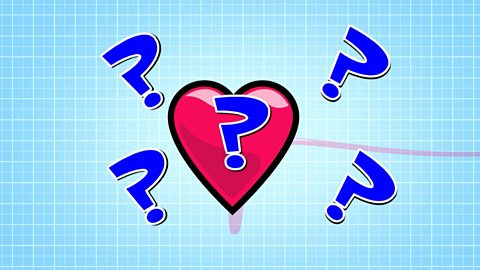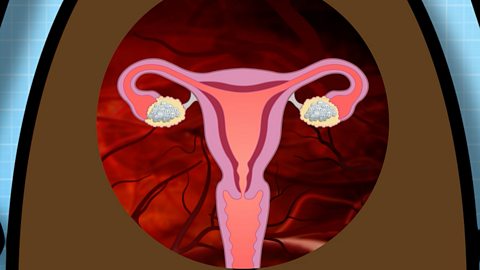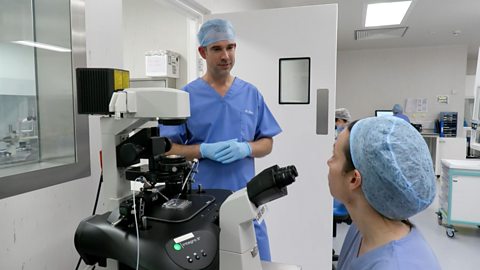All new babies start as an egg and a sperm, but where do those two cells come from in the first place?
Your reproductive organs produce the sex cells that make a baby. Sperm cells begin their life in males, right here in the testicles; whereas egg cells start their life in females, in the ovaries.
As well as the ovaries, inside a female there are the fallopian tubes, uterus and the vagina
And inside a male as well as the testicles or testes, there is the sperm duct.
The human reproductive system is an amazing bit of body kit.
It also has parts on the outside of the body which are called genitals.
The medical words to describe male genitals are the penis and the scrotum
And the medical words for female genitals are the vulva and labia. So many words for a really complex bit of body kit. But lots of families have their own name for genitals such as private parts.
Our reproductive systems do a brilliant job of making the sex cells an egg or a sperm, but when, why and how do these cells start to be made? To find out we need to talk about puberty.
Video summary
This short film introduces the topic of reproduction, genitals and reproductive body parts. It explains that babies start from an egg and a sperm.
Correct terminology is given for genitals and reproductive body parts in male and female bodies.
This film is relevant to science or sex education, as well as health education. Remember that schools need to be able to draw a line between their curricula for relationships education and sex education in order to implement the parental right to request their child is excused from sex education.
Please ensure you watch the film prior to using it in class, to ensure it is suitable for your pupils and in line with your school's policy for RSHE. Further guidance is given below.
╠²
Before watching the clip
Use baseline assessment to establish current knowledge. Discuss with other teachers and link to their curriculum.
Consider:
- Do students know correct terminology for genitals?
- What has been delivered previously in science?
- Do students know how a baby is conceived and born?
- The impact the word ÔÇÿsexÔÇÖ will have on your lesson.
╠²
Safeguarding
Teaching about bodies requires sensitive and well-judged teaching based on knowledge of pupils and their circumstances.
Creating a safe space for RSHE lessons is important, including encouraging pupils to respect others through listening and being mindful of otherÔÇÖs feelings.
- Give some thought to what is happening before and after the lesson for those pupils and how to provide opportunities for them to ask questions, anonymously or face-to-face.
- Remind pupils where to go for good answers to their questions.
- The whole school community needs to be aware of when these lessons are taking place, to enable all staff to respond to questions in a supportive and informative way.
- With your RSHE lead, discuss ways of responding to common questions that reflect your schoolÔÇÖs ethos and RSHE policy.
- Be aware of your school safeguarding policy and procedures for safeguarding disclosures and concerns.
Please note - this clip refers to the vulva and the labia. See on female genital mutilation (FGM). Specifically paragraph 40 and the Annex B ÔÇÿSo-called ÔÇÿhonourÔÇÖ-based abuse (including female genital mutilation and forced marriage)ÔÇÖ.
╠²
SEND
Refer to the ÔÇÿpreparing for adulthoodÔÇÖ outcomes as set out in the SEND code of practice ÔÇô schools should support children in developing friendships.
╠²
Topics that are addressed in other clips
- Are all babies born with sperm/egg cells?
- How does the sperm get out?
- How does the sperm meet the egg?
- Do all eggs become babies?
- Can you choose when to have a baby?
╠²
Further information for teachers
You may wish to refer to which is an American website with a range of animations. This may support your subject knowledge.
╠²
Signposting for pupils
╠²
Links to guidance
Please refer to paragraph 65 ÔÇÿSex EducationÔÇÖ.
Sex education is not compulsory in primary schools, but schools should determine their content based on the needs of their pupils and this may include additional sex education content.
main external body parts, puberty, and reproduction in plants and animals, how a baby is conceived and born.
Keywords
Egg, sperm, cells, reproductive organs, sex cells, testicles, ovaries, fallopian tubes, uterus, vagina, testicles, testes, sperm duct, genitals, penis, scrotum, vulva, labia, puberty
╠²
Discussion
- Do the illustrations and animations in this clip represent real body shapes?
- Bodies comes in different shapes and sizes not everyone has a sixpack!
- Do people always use correct terminology for their genitals? If not, why not?
- Why is it helpful to know how to talk about bodies using the correct medical words?
Draw attention to the fact that there are many different types of bodies. Bodies can look different. Encourage the use of correct terminology and the importance of asking for help from medical professionals.
Relationships and families. video
This short film is about combinations of humans that can make up a family: mothers and fathers, sisters, brothers, dogs, two fathers, two mothers, foster families. It introduces the concept of biological parents, adoptive parents, foster parents, and divorced parents.

Puberty. video
This short film looks at puberty and why it happens, defining it as changing from a child to a reproductive adult. There is a description of the changes that happen in most bodies, what that may mean for female bodies and male bodies, when it might happen and that it is normal.

What is attraction? video
This short film is about feelings of attraction that can begin to happen during puberty. They can feel warm, exciting, and sometimes confusing.

Sex and sexual intercourse. video
This short film talks about genitals, arousal, sexual intercourse, and fertilisation. It sets out that this is something that can happen when a man and woman decide to have sex to make a baby, and that this is the most common way of fertilisation.

In vitro fertilisation (IVF) video
This short film explains IVF - a procedure used to help people who cannot conceive via sexual intercourse. It is used to help people to get their eggs and sperm to meet, fertilise and hopefully make a baby.
